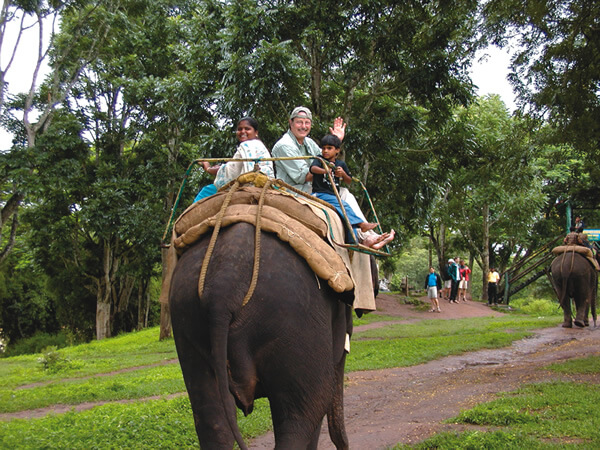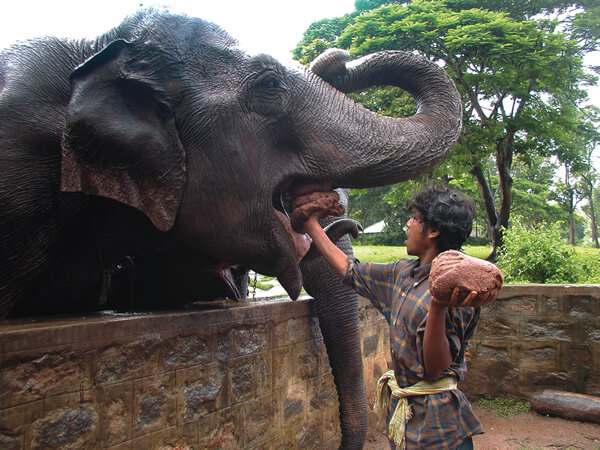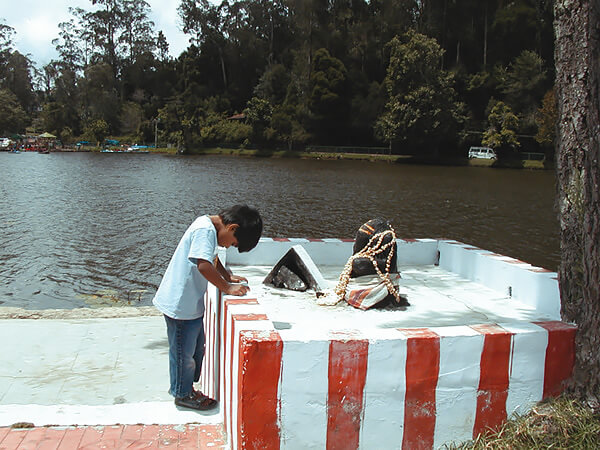|
An Elephant Escape
South India Elephant Sanctuaries Double as Eco-Lodges and Learning Centers
Article and Photos by Deborah McLaren

|
|
Anil and friends ride an elephant through Dubare Elephant Camp.
|
My 6-year-old son, Anil, is originally from India so going back to visit his homeland is a priority for our family. One of his dreams has been to learn about and ride on an elephant, so we decided to do just that! Through
recommendations, the web, and eco-travel lists, we discovered Dubare Elephant Camp (part of Jungle Lodges, an Indian government-private partnership that runs a series of wildlife camps), as well as the privately run Elephant
Valley.
Dubare Elephant Camp
From Mysore, in Karnataka, we drove northwest to the Cauvary River, which was flooded due to the monsoon rains. When we arrived we were directed into a small motor boat, which battled the raging, flooded waters to reach
the elephant camp on the far shore. The camp is set up as a free-roaming area for the elephants with separate areas for feeding and training, as well as tourist quarters and an open-air restaurant.
Our stone cabin was simple but extremely clean, interestingly decorated, and cozy. The head chef prepared delicious south Indian meals that included rice cakes (iddlys) and curries. We saw one of the fish used for our dinners
being hand-delivered from the river to the cookhouse. In the evening, we watched films about elephant ecology, in particular the plight of the elephants at Dubare Elephant Camp.
Traditionally, local tribal men trained as mahouts (elephant handlers or drivers), begin their job from boyhood, when each is assigned a baby elephant to work with throughout their lifetimes. An elephant is considered part
of the family, and the role of the family is to pass critical knowledge and skills needed from one generation to the next. The young mahout grows up with his elephant, and together they develop a bond based on trust and affection.
Elephants are very social animals, having their own community rules and customs. Their large brains let them record memories and store experiences such as droughts, migration routes, and the best feeding places. Elephants
create strongly bonded family units and appear to communicate over relatively long distances by means of infrasonic (low frequency) calls that we are not able to hear with our human ears. They have also been venerated in India for hundreds of
years and are the carriers of Indra, the King of the Gods. Elephant festivals and ceremonies are common. The annual Ganpathi observance celebrates the elephant-headed God Ganesh and is one of the most important holidays of the year. They serve
as the emblem of Buddhism and are prominent in the stories of the Buddha.

|
|
Camp workers prepare wheat, sorgum, and other grains into tasty treats to hand-feed the elephants.
|
In the past elephants were used primarily for logging the forests (as well as for hauling, military work, and in temples); however, with dwindling forests and increased efforts to protect elephants, they are being spared
this brutal work, which damages their trunks and tusks. In addition, elephants have been brutally killed for their tusks to the point of becoming an endangered species. The large-scale poaching of elephants for ivory started in earnest in the
late seventies and has been an ongoing threat ever since. There are still many problems facing these amazing animals, mostly problems brought about by humans.
Some elephants, however, are enjoying less stressed lives as they find protection as an endangered species and are used more and more in tourism. Along with these changes, local young men have renewed interest in working
with the elephants, reviving the tradition of mahouts.
In the morning the manager of the camp escorted us through the jungle and provided us with details about the wildlife and history of the camp. A highlight was watching the camp men boil and prepare giant grain balls for
the elephant’s breakfast. The hungry pachyderms gathered nearby for their early meal. Anil was quite taken by a young elephant that specialized in using his trunk to steal food right out of his elder’s mouths.
After breakfast we enjoyed a short elephant ride and participated in an elephant scrub bath. One of the ways mahouts and elephants enjoy a strong bond is through a daily ritual of bathing. This practice allows the mahouts
to gain an intimate understanding of their elephants and to cultivate relationships that allow them to control the elephants through touch and with simple verbal commands.
Elephant Valley Eco-Lodge
A few days later we traveled to Elephant Valley, near Kodaikanal, a hill station in Tamil Nadu. Spread over 100 acres, it is part eco-lodge, part nature reserve, and part organic coffee plantation. Our cottage was built
with local granite, reclaimed Burma teak, and colonial art deco furniture from India. The privately run estate uses solar lights, kerosene lamps, and dry composting toilets. A huge organic garden and coffee estate provides local jobs and makes
a contribution to sustainable development in the region.

|
|
Anil stops at a roadside temple to pay respects to Ganesh, the elephant-headed Hindu god.
|
The Elephant Valley staff members are involved in numerous efforts in vegetable gardening, seed sowing, transplanting, harvesting, composting, earth worm cultivation, eco-sanitation, nutrition, water and soil conservation,
forest botany, and cultural preservation. They also promote the conservation of genuine traditional varieties of vegetables through their organic farm where all types of fruits, vegetables and spices including coffee are grown by using traditional
methods of organic farming. All of the food that is provided to the guests come from the farm and is cooked in traditional local Indian style. It’s one of the few places in India we were able to devour tasty fresh salads without worrying
about getting sick. The farm often hosts programs for local schools including the nearby Kodaikanal International School.
Elephant Valley is situated on the edge of the forest and on an ancient elephant migratory route. While we did not see elephants during our 3-day stay, we saw visible evidence of them as the estate manager and naturalist
taught us how to track them. A path of squashed plants, bent trees, and fresh elephant dung allowed us to follow the tracks of a mother and a young elephant that passed by only a few hundred feet from our cottage.
Anil enjoyed trekking, especially a half-hour walk to the top of a waterfall, the point where the cascade leaps off a precipitous cliff. A longer, 2-hour trek took us through jungle and hilltops where we saw Neolithic dolmens,
similar to those in Europe. Placed at intervals close enough to watch people travel from one to another, some scientists argue that they served as a small protective fortress from wild animals for hunters and travelers. We were able to view a
lot of wildlife, including a close (enough) encounter with a guar, or wild jungle bison.
It was a real treat to stay at Dubare Elephant Camp and Elephant Valley, both of which were great learning experiences. We are already looking forward to our next visit and have been seriously inspired to learn more about
Asian elephants in the meantime.
|
For More Info
Jungle Lodges & Resorts was established in 1980 and has since won rare accolades, including the Government of India Award for Excellence for eco-friendly tourism. It maintains several
wildlife areas and offers varying levels of accommodation (some are world class).
Eco-Friendly Places to stay in India
The Wildlife Trust of India is working to create a network of forest corridors to enable India’s elephants to move safely between protected areas and
to avoid human-elephant conflict and protect critical elephant habitat. This project also benefits villagers who live close to the corridors by reducing conflict near the corridors and by providing the financial capability and expertise
to create alternative livelihoods to the “slash-and burn” agriculture that has led to the rapid depletion of the natural forests.
|
Deborah McLaren is a travel writer, author, teacher, and consultant who lives in St. Paul, MN. She has worked on community-based sustainable tourism from the Amazon to the Arctic.
|
